Complete Solutions to EXAMPLE of chapter TRIANGLES of Class 10 book with complete answers and questions
| Class 10 | MATHS |
| Chapter | TRIANGLES |
| MBD | EXAMPLE |
| Number Of Questions | 81 |
| Academic Year | 2023-24 |
Fill in the blanks using the correct word given in brackets :- All circles are ………. (congruent,similar)
View SolutionFill in the blanks using the correct word given in brackets :- All squares are………. (similar,congruent) .
View SolutionFill in the blanks using the correct word given in brackets :- All ………. Triangles are similar . (isosceles,equilateral).
View SolutionFill in the blanks using the correct word given in brackets :- Two polygons of the same number of sides are similar, if :- their corresponding angles are…….. (equal , proportional).
View SolutionFill in the blanks using the correct word given in brackets :- Two polygons of the same number of sides are similar, if :- their corresponding sides are…….. (equal , proportional).
View SolutionGive two different examples of pair of ,- similar figures.
View SolutionGive two different examples of pair of ,- non-similar figures.
View SolutionState whether the following quadrilaterals are similar or not :-
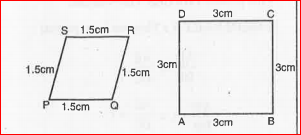
View SolutionIn fig. (i) and (ii), DE || BC. Find EC in (i) and AD in (ii).
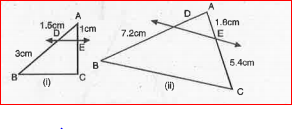 .
.
View SolutionE and F are points on the sides PQ and PR respectively of a `anglePQR`. For each of the following cases, state whether EF || OR : PE = 3.9 cm, EQ = 3 cm, PF = 3.6 cm and FR = 2.4 cm.
View SolutionE and F are points on the sides PQ and PR respectively of a `anglePQR`. For each of the following cases, state whether EF || OR : PE = 4 cm, QE = 4.5 cm, PF = 8 cm and RF = 9 cm.
View SolutionE and F are points on the sides PQ and PR respectively of a `anglePQR`. For each of the following cases, state whether EF || QR : PQ = 1.28 cm, PR = 2.56 cm, PE = 0.18 cm and PF = 0.36 cm.
View SolutionIn fig., LM || CB , and LN||CD.Prove that `(AM)/(AB)=(AN)/(AD)` .
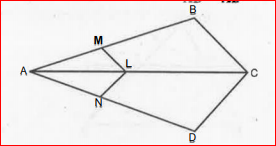 .
.
View SolutionIn fig. DE || AC, and DF || AE prove that `(BF)/(EF)=(BE)/(EC)` .
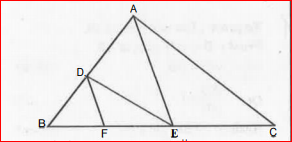 .
.
View SolutionIn fig., A, B and C are points on OP, OQ and OR respectively such that AB || PQ and AC || PR. Show that BC || QR.
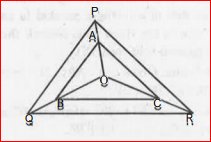 .
.
View SolutionUsing Basic Proportionality theorem, prove thata line drawn through the mid-point of one side of a triangle parallel to another side bisects the third side. (Recall that you have proved it in class IX).
View SolutionUsing converse of Basic Proportionality theorem prove that the line joining the mid-points of any two sides of a triangle is parallel to the third side. (Recall that you have done it in Class IX).
View SolutionABCD is a trapezium in which AB II DC and its diagonals intersect each other at the point O. show that `(AO)/(BO)=(CO)/(DO)` .
View SolutionThe diagonals of a quadrilateral ABCD intersect each other at the point o Such that `(AO)/(BO)=(CO)/(DO)` , show that ABCD is trapezium.
View SolutionState which pairs of triangles in Fig. are similar. Write the similarity criterion used by you for answering the question and also write the pairs of similar triangles in the symbolic form :
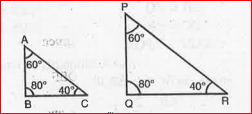
View SolutionState which pairs of triangles in Fig. are similar. Write the similarity criterion used by you for answering the question and also write the pairs of similar triangles in the symbolic form :
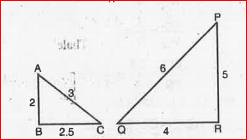
View SolutionState which pairs of triangles in Fig. are similar. Write the similarity criterion used by you for answering the question and also write the pairs of similar triangles in the symbolic form :
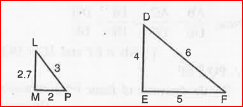
View SolutionState which pairs of triangles in Fig. are similar. Write the similarity criterion used by you for answering the question and also write the pairs of similar triangles in the symbolic form :
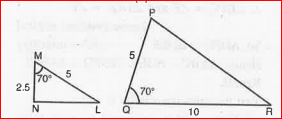
View SolutionState which pairs of triangles in Fig. are similar. Write the similarity criterion used by you for answering the question and also write the pairs of similar triangles in the symbolic form :
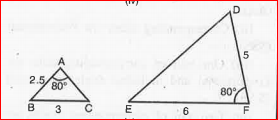
View SolutionState which pairs of triangles in Fig. are similar. Write the similarity criterion used by you for answering the question and also write the pairs of similar triangles in the symbolic form :

View SolutionIn fig., `triangleODC-triangleOBA`, `angleBOC=125@0 ` and `angleCDO=70@0`. Find `angleDOC`, `angleDCO` and `angleOAB` .

View SolutionDiagonals AC and BD of a trapezium ABCD with AB || DC intersect each other at the point O. Using a similarity criterion for two triangles , show that `(OA)/(OC)=(OB)/(OD)` .
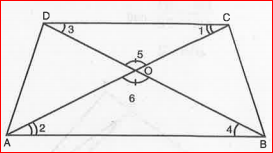 .
.
View SolutionIn fig., `(QR)/(QS)=(QT)/(PR)` and `angle1=angle2` . Show that `trianglePQS~triangleTQR` .
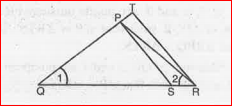 .
.
View SolutionS and T are points on sides PR and QR of `trianglePQR` such that `angleP`=`angleRTS` .Show that `triangleRPQ~triangleRTS` .
View SolutionIn figure `triangleABE=triangleACD` show that `triangleADE~triangleABC` .
 .
.
View SolutionIn Fig., altitudes AD and CE of `triangleABC` intersect each other at the point P. Show that :- `triangleAEP~triangleCDP` .
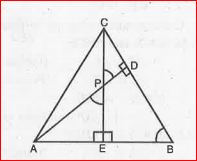 .
.
View SolutionIn Fig., altitudes AD and CE of `triangleABC` intersect each other at the point P. Show that :- `triangleABD~triangleCBE` .
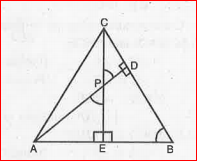 .
.
View SolutionIn Fig., altitudes AD and CE of `triangleABC` intersect each other at the point P. Show that :- `triangleAEP~triangleADB` .
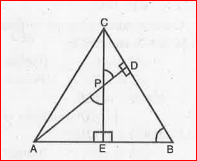 .
.
View SolutionIn Fig., altitudes AD and CE of `triangleABC` intersect each other at the point P. Show that :- `trianglePDC~triangleBEC` .
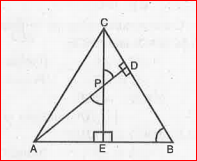 .
.
View SolutionE is a point on the side AD produced of a parallelogram ABCD and BE intersects CD at F. Show that `triangleABE ~ triangleCFB` .
View SolutionIn Fig., ABC and AMP are two right triangles, right angled at B and M respectively. Prove that :- `triangleABC~ triangleAMP` .
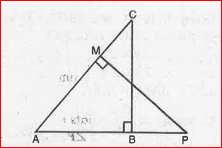 .
.
View SolutionIn Fig., ABC and AMP are two right triangles, right angled at B and M respectively. Prove that :- `(CA)/(PA)=(BC)/(MP)` .
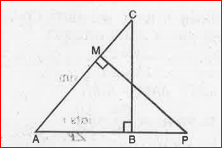 .
.
View SolutionCD and GH are respectively the bisectors of `angleACB` and `angleEGF` such that D and H lie on sides AB and FE of `triangleABC` and `triangleEFG` respectively. If `triangleABC ~ triangleFEG`, show that :-`(CD)/(GH)=(AC)/(FG)` .
View SolutionCD and GH are respectively the bisectors of `angleACB` and `angleEGF` such that D and H lie on sides AB and FE of `triangleABC` and `triangleEFG` respectively. If `triangleABC ~ triangleFEG`, show that :- `triangleDCB~triangleHGE` .
View SolutionCD and GH are respectively the bisectors of `angleACB` and `angleEGF` such that D and H lie on sides AB and FE of `triangleABC` and `triangleEFG` respectively. If `triangleABC ~ triangleFEG`, show that :- `triangleDCA~triangleHGF` .
View SolutionIn Fig., E is a point on side CB produced of an isosceles triangle ABC with AB = AC. If AD `bot` BC and EF `bot` AC, prove that `triangleABD ~ triangle` ECF.
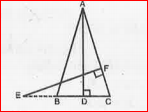 .
.
View SolutionSides AB and BC and median AD of a triangle ABC are respectively proportional to sides PQ and QR and median PM of `trianglePQR` (see Fig.). Show that `triangleABC ~ trianglePQR` .
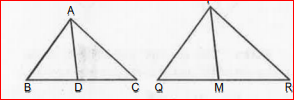 .
.
View SolutionD is a point on the side BC of a triangle ABC such that `angleADC` = `angleBAC` . Show that `CA^2` = CB. CD.
View SolutionSides AB and AC and median AD of a triangle ABC are proportional to sides PQ and PR and median PM of another triangle PQR. Prove that `triangleABC - trianglePQR` .
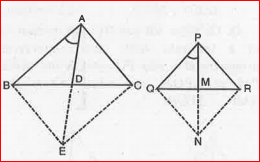 .
.
View SolutionA vertical pole of length 6 m casts a shadow 4 m long on the ground and at the same time a tower casts a shadow 28 m long. Find the height of the tower.
View SolutionIf AD and PM are medians of triangles ABC and PQR, respectively where `triangleABC~ trianglePQR` , Prove that `(AB)/(PQ)=(AD)/(PM)` .
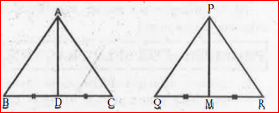 .
.
View SolutionIf the areas of two similar triangles are equal, prove that they are congruent.
View SolutionD, E and F are respectively the mid¬ points of the sides BC, CA and AB of `triangleABC`. Determine the ratio of the areas of triangles DEF and ABC.
View SolutionProve that the ratio of the areas of two similar triangles is equal to the square of the ratio of their corresponding medians.
View SolutionProve that the areas of the equilateral triangle described on the side of a square is equal to half the area of the equilateral triangle described on one of its diagonal.
View SolutionSides of triangles are given below. Determine which of them are right triangles. In case of a right triangle, write the length of its hypotenuse. :- 7 cm, 24 cm, 25 cm
View SolutionSides of triangles are given below. Determine which of them are right triangles. In case of a right triangle, write the length of its hypotenuse. :- 3 cm, 8 cm, 6 cm.
View SolutionSides of triangles are given below. Determine which of them are right triangles. In case of a right triangle, write the length of its hypotenuse. :- 50 cm, 80 cm, 100 cm.
View SolutionSides of triangles are given below. Determine which of them are right triangles. In case of a right triangle, write the length of its hypotenuse. :- 13 cm, 12 cm, 5 cm.
View SolutionPQR is a triangle right angled at P and M is a point on QR such that PM `bot` QR. Show that `PM^2` = QM.MR.
View SolutionIn fig., ABD is a triangle right angled at A and AC `bot` BD. Show that:- `AB^2`=BC.BD .
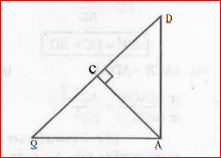
View SolutionIn fig., ABD is a triangle right angled at A and AC `bot` BD. Show that:- `AC^2`= BC.DC .
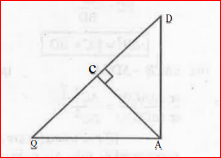
View SolutionIn fig., ABD is a triangle right angled at A and AC `bot` BD. Show that:- `AD^2`=BD.CD .
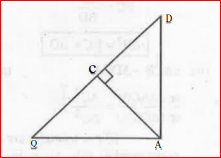
View SolutionABC is an isosceles triangle right angled at C. Prove that `AB^2` = `2AC^2`.
View SolutionABC is an isosceles triangle with AC = BC. If `AB^2` = `2AC^2`, prove that ABC is right triangle.
View SolutionABC is an equilateral triangle ofside 2a. Find each of its altitudes.
View SolutionProve that the sum of the squares of the sides of a rhombus is equal to the sum of the squares of its diagonals.
View SolutionIn fig., O is a point in the interior of a triangle ABC, OD `bot` BC, OE `bot` AC and OF `bot` AB. Show that:- `OA^2+OB^2+OC^2-OD^2-OE^2-OF^2=AF^2+BD^2+CE^2` .
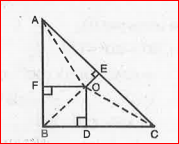
View SolutionIn fig., O is a point in the interior of a triangle ABC, OD `bot` BC, OE `bot` AC and OF `bot` AB. Show that:- `AF^2+BD^2+CE^2=AE^2+CD^2+BF^2` .
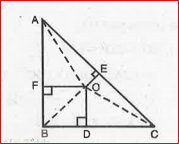 .
.
View SolutionA ladder 10 m long reaches a window 8 m above the ground. Find the distance of the foot of the ladder from base of the wall.
View SolutionA guy wire attached to a vertical pole of height 18 m is 24 m long and has a stake attached to the other end. How far from the base of the pole should the stake be driven so that the wire will be taut ?
View SolutionAn aeroplane leaves an airport and flies due north at a speed of 1000km per hour. At the same time, another aeroplane leaves the same airport and flies due west at a speed of 1200 km per hour. How far apart will be the two planes after `1 1/2` hours ?
View SolutionTwo poles of heights 6 m and 11 m stand on a plane ground. If the distance between the feet of the poles is 12 m, find the distance between their tops.
View SolutionD and E are points on the sides CA and CB respectively of a triangle ABC right angled at C. Prove that `AE^2+BD^2=AB^2+DE^2` .
View SolutionIn fig., ABC is triangle in which `angleABC > 90@0` and AD `bot` BC produced, prove that `AC^2 = AB^2 + BC^2 + 2BC.BD` .
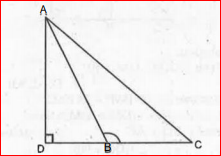 .
.
View SolutionIn fig., ABC is a triangle in which `angleABC < 90@0, and AD 'bot` BC produced, prove that `AC^2 = AB^2 + BC^2 - 2BC.BD` .
 .
.
View SolutionIn fig., AD is a median of a triangle ABC and AM `bot` BC.Prove that :- `AC^2=AD^2+BC.DM+((BC)/2)^2` .
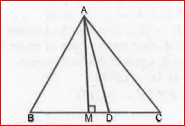 .
.
View SolutionIn fig., AD is a median of a triangle ABC and AM `bot` BC.Prove that :- `AB^2=AD^2-BC.DM+((BC)/2)^2` .
 .
.
View SolutionIn fig., AD is a median of a triangle ABC and AM `bot` BC.Prove that :- `AC^2+AB^2= 2AD^2+1/2BC^2`.
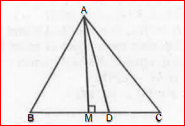 .
.
View SolutionProve that sum of squares of the diagonals of a parallelogram is equal to sum of squares of its sides.
View SolutionIn fig., two chords AB and CD intersect each other at the point P prove that :- `triangleAPC~triangleDPB` .
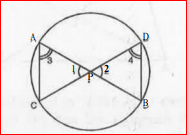 .
.
View SolutionIn fig., two chords AB and CD intersect each other at the point P prove that :- AP.PB=CP.DP.
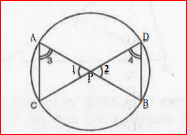 .
.
View SolutionIn fig., two chords AB and CD of a circle intersect each other at point P (when produced) outside the circle prove :- `trianglePCA~trianglePDB`
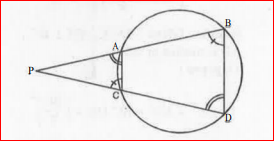 .
.
View SolutionIn fig., two chords AB and CD of a circle intersect each other at point P (when produced) outside the circle prove :- PA.PB=PC.PD
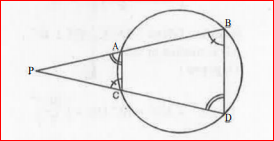 .
.
View SolutionIn fig., D is a point on side BC of `triangleABC` such that `(BD)/(DC)=(AB)/(AC)` . Prove that, AD is bisector of `angleBAC` .
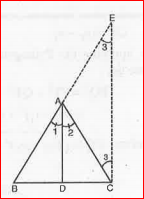 .
.
View SolutionNazima is fly fishing in a stream. The tip of her fishing rod is 1.8 m above the surface of the water and the fly at the end of the string rests on the water 3.6 m away and 2.4 m from a point directly under the tip of the rod. Assuming that her string (from the tip of her rod to the fly) is taut, how much string does she have out ? If she pulls in the string at the rate of 5 cm per second, what will the horizontal distance of the fly from her after 12 seconds ?
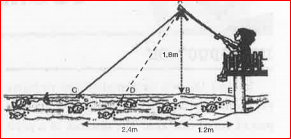 .
.
View Solution
EXAMPLE questions and complete solutions for chapter TRIANGLES of MBD of Class 10